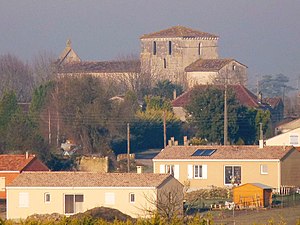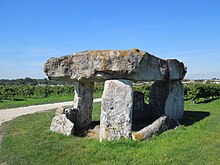Saint-Fort-sur-le-Ne
| Saint-Fort-sur-le-Ne | ||
|---|---|---|

|
|
|
| region | Nouvelle-Aquitaine | |
| Department | Charente | |
| Arrondissement | cognac | |
| Canton | Charente-Champagne | |
| Community association | Grand Cognac | |
| Coordinates | 45 ° 35 ′ N , 0 ° 18 ′ W | |
| height | 16-65 m | |
| surface | 6.8 km 2 | |
| Residents | 372 (January 1, 2017) | |
| Population density | 55 inhabitants / km 2 | |
| Post Code | 16130 | |
| INSEE code | 16316 | |
 Saint-Fort-sur-le-Né - the townscape |
||
Saint-Fort-sur-le- Né is a southwestern French community with 372 inhabitants (at January 1, 2017) in the department of Charente in the region Nouvelle-Aquitaine ; it belongs to the arrondissement of Cognac and the canton of Charente-Champagne .
location
The community is 13.5 kilometers (driving distance) south of the city of Cognac at an altitude of 25 to 30 meters above sea level. d. M. The river Né , a left tributary of the Charente , forms the western municipal boundary and the border with the Charente-Maritime department . The neighboring municipalities are Salles-d'Angles (5 kilometers northwest), Angeac-Champagne (4.5 kilometers north), Juillac-le-Coq (4.5 kilometers east), Verrières (3.5 kilometers southeast) and Saint-Palais -du-Né (6 kilometers southeast).
Population development
| year | 1968 | 1975 | 1982 | 1990 | 1999 | 2007 | 2016 |
| Residents | 464 | 406 | 419 | 402 | 386 | 399 | 365 |
At the first census in France in 1793, the place had 509 inhabitants; after that the population fluctuated between 400 and almost 600 inhabitants. The phylloxera crisis (approx. 1865–1885), which resulted in a significant decline in the population in almost all wine-growing regions in France, had hardly any effect.
economy
Agriculture and especially viticulture have always played an important role in the Charente villages. While cereals, vegetables and oilseeds ( sunflowers ) were mainly grown for their own needs, one could earn good money with the export of wine (later also brandy) to England, Scotland and other countries in Northern Europe, although the winegrowers with the less Part of the earnings had to be satisfied. Today the south bank of the Charente near Saint-Fort-sur-le-Né is part of the Grande Champagne location within the large growing area for cognac wines. There is a distillery in the village for the production of Eau-de-Vie , the clear starting product of cognac.
history
One of the most imposing megalithic dolmens in south-west France stands on the territory of the commune . Fragments of Gallo-Roman ceramics and roof tiles ( tuiles ) were also found - clear indications of settlement during this period. In the Middle Ages, the area of today's community to belong lordship of the lords of Ambleville . In the Hundred Years War (1337-1453) the church was destroyed by the English; Nothing is known about the destruction during the Huguenot Wars (1562–1598). During the French Revolution , the place was temporarily only called Fort-de-Né .
Attractions
- The megalithic dolmen de la Pierre Levée stands southeast of the village in the middle of the vineyards; he is around 3500 BC Dated. Only three of the formerly six or seven supporting stones ( orthostats ) bear the enormous weight of the approximately 7.2 meter long and approximately 4.70 meter wide cover plate, which seems to float at a clear height of about 2.20 meters above the building. While the cover plate is largely unhewn, the bearing stones are smoothed and cut into a rectangular shape so that they could be placed next to each other almost without any gaps. The remaining gaps between and above the orthostats were filled with rubble stones; possibly the entire building was covered by a burial mound that was removed over time. The dolmen has been on the list of historical monuments since 1983 .
- The Romanesque parish church of Saint-Fortunat (or Saint-Fort ) dates from the 12th century. In the 15th century the church was - as it is said by the English - destroyed; During the reconstruction, a rib vault was drawn in and the building was stabilized by powerful buttresses. In the 19th century, the church building was fundamentally revised - the west facade was completely renewed. The single-nave, almost Spartan-looking interior has a flat, apse-free end of the choir , which is blocked by a baroque altarpiece . The church has been recognized as a monument historique since 1991 .
- The Chapelle de Renorville is a half-ruined burial chapel above a crypt from the 19th century.
Individual evidence
- ↑ Saint-Fort-su-le-Né, Dolmen de la Pierre Levée in the Base Mérimée of the French Ministry of Culture (French)
- ↑ Saint-Fort-sur-le-Né, Dolmen de la Pierre Levée in the Base Mérimée of the French Ministry of Culture (French)
- ↑ Saint-Fort-sur-le-Né, Église Saint-Fortunat in the Base Mérimée of the French Ministry of Culture (French)
- ↑ Saint-Fort-sur-le-Né, Église Saint-Fortunat in the Base Mérimée of the French Ministry of Culture (French)


